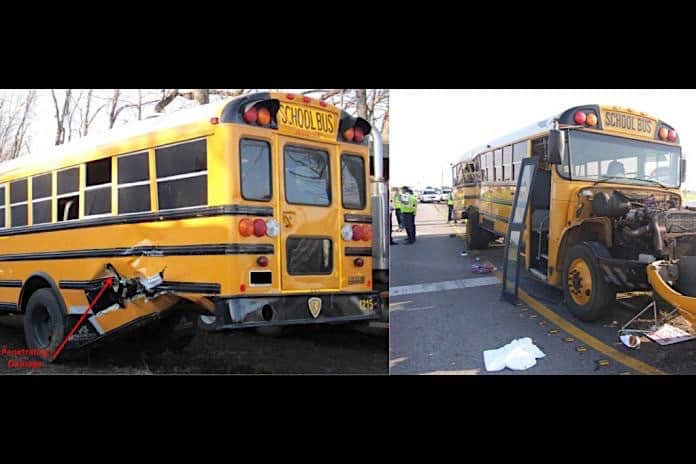The School Bus Manufacturers Technical Council has petitioned the National Highway Traffic Safety Administration to determine if the structural integrity of the school bus seating and restraint system needs to be changed, stating that it is in the best position to undertake an analysis of FMVSS No. 222. The request came in response to a National Transportation Safety Board recommendation regarding three-point belts for school buses.
The issue is at the center of an NTSB investigation into two fatal school bus crashes occurring about a month a part from each other in 2012 — the first on Feb. 16 of that year in Chesterfield, New Jersey, and the second on March 26 in Port St. Lucie, Florida. Both incidents involved a truck striking the school bus from the side, causing high lateral and rotational accelerations that contributed to the fatalities and injuries.
In its final analysis of the New Jersey crash and an attached review of the Port St. Lucie crash that was finalized on July 23, 2013, NTSB recommended to SBMTC that it “develop a recommended practice for establishing and safeguarding the structural integrity of the entire school bus seating and restraint system, including the seat pan attachment to the seat frame, in severe crashes — in particular, those involving lateral impacts with vehicles of large mass.”
In the Port St. Lucie crash, one seat pan with the self-latching mechanism became dislodged. All the seat pans in New Jersey collision held up. Both students killed in each crash were not wearing their lap belts, NTSB concluded.
But in a letter addressed to NTSB Chairman Christopher Hart dated on July 31, SBMTC pointed out that it does not have the authority or the mandate to enforce regulations in the school bus industry. Instead, wrote SBMTC Chairman Ken Whisnant, NHTSA must study NTSB’s crash report “and to conduct any additional studies and develop new regulations and or changes in current regulations” as necessary.
“This approach ensures that all systems required on school buses work in conjunction with any new regulation and that there are no unintended consequences of such changes,” Whisnant continued. “Implementing the NTSB recommendation by means of a federal safety standard, if warranted, would require that all school bus and school bus seat manufacturers currently in the market and any potential new manufacturers adhere to the same level of compliance testing and quality assurance that goes into making school buses the safest form of transportation in the world today.”
He added that the SBMTC believes that all manufacturers are already using lateral seat stability in their seat designs in compliance with the most recent changes to FMVSS 222 effective for all new school buses on and after Oct. 21, 2009.
In a letter addressed to NHTSA Administrator Mark Rosekind, Whisnant said SBMTC does not believe that an industry-recommended practice is the proper way to address NTSB’s recommendation.
On July 23, Rosekind convened a meeting with student transportation professionals and safety board officials to discuss ways to improve school bus passenger safety, including but not limited to seatbelt implementation.















